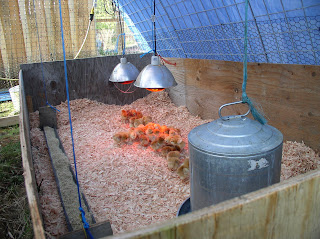 |
| Rocky the Rooster with some of his girls |
One of the local feed stores we use were giving away day-old chicks if you purchased items from their farm store, so we saved our receipts and got 15 free Rhode Island Reds (all girls) on April 15th of 2009. They began laying their first eggs in late summer. We chose the Rhode Island Red for a couple of reasons: they are considered a duel purpose bird, a very good egg layer of large brown eggs and also an above average meat bird. Our plan is to keep the layers for three years and then butcher them. We eat about a dozen eggs a week and were getting a dozen eggs a day so I went into the egg selling business and have been able to sell all of our excess eggs to co-workers.
We have lost a couple birds to who knows what, finding them dead on the floor of the coop or in their nest, and we lost one to a hawk, but over all they have done well. We wanted a rooster so we ran an ad on Craigslist for a Rhode Island Red rooster and got a young one who the owner called "Boy Model" - we renamed him Rocky. Yes he is a beautiful bird and is very good with his girls, but Rhode Island Red roosters are known to be mean to people, and he and I have had several fights. Pam won't go into the area without a spray bottle of water to squirt him. That seems to work well.
Even with nice nest boxes the girls like to find hidden places to lay their eggs, often adding the to the duck nests. When one of our ducks became broody this last spring it seems she also had several chicken eggs in her nest and one day hatched a Rhode Island Red chick. Chicken eggs hatch about 15 days before the Muscovy so our duck had this chicken to care for. The nest was under the chicken coop and I could watch the going on. As "Chick-Chick" grew she would roost on the head of the duck, whose duck eggs never hatched. So cute! Chick-Chick has grown into a fine bird, a rooster and has been renamed Junior. He looks just like his Papa. Last week he started to crow, if his crow matures into one we like it's the stew pot for Rocky - there is no place here for a mean rooster!
 |
| "Chick-Chick" with his mother the Duck |
The instructor had success with the Red Rock (aka Red Ranger), which is what we ordered. They take three months to mature but over that time eat about the same amount of grain as the Cornish Rock. We received 50 in the mail one fine morning and I put them into the new meat bird house I built. They grew into a fine looking bird, somewhat like the Rhode Island Red but with a little more black in them. The instructor also had built a chicken plucker and would rent it out for 50 cents per bird.
 |
| Our day old Red Rock meat birds |
 |
| The meat bird house |
We had a table set up with two large trash cans filled with ice water. Once Pam gutted and cleaned the birds they went into the ice water. We processed 22 birds in about four hours from start to finish. The boys dressed out a 6.5 lbs, the girls at 4.5 lbs. 43 birds went into the freezer for our year's supply of chicken. Our cost was about $10 per bird. Free range, organic chickens in the local supermarket sell for about $20, and are shipped in from across the country, and who knows if they are really "free range" or just have the option to go outside. Ours spent all day in the tall grass in a pasture that has never had pesticides sprayed and ate only organic grain. The only change we'll make this year is to do a better job on grounding the electrical poultry netting I used around the pasture. I didn't do a good job on that this year and the jolt from the fence was not strong enough to keep the local fox out. One of my spring projects for sure.

Wow! Great post! I have loved our RIR's. Now we only have one... and I think she's about to die (she's been sick for a week now, can't figure out what's wrong). We mostly have Buff Orpingtons now, and I love them. I think they are dual purpose birds as well. We had to get rid of our Buff Rooster though... he was just TOO mean. I LOVED the duck with the chick. How cute is that!! I haven't had any luck with any of our hens going broody yet. I wish they would!! Thanks for sharing all of this info. I love your setup. Everything looks so good.
ReplyDelete